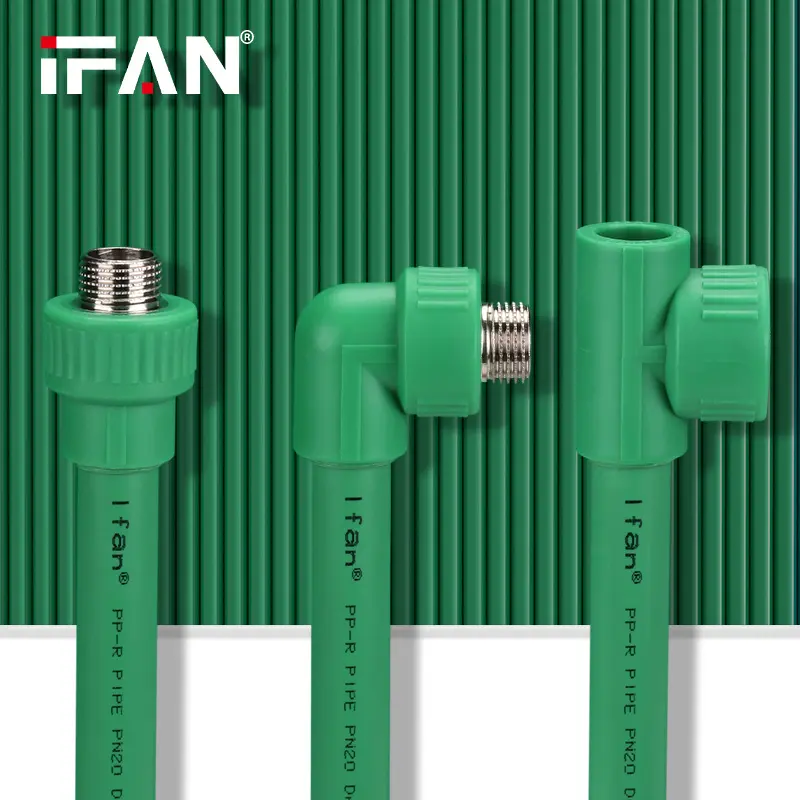What Are PPR Pipe Fittings?
An In-Depth Look at Polypropylene Random Copolymer Plumbing System Components
Polypropylene random copolymer (PPR) has become a popular piping material for modern plumbing systems. PPR pipe fittings are essential components that allow the assembly of complete PPR piping networks. This article explores what PPR fittings are and their importance.IFAN factory with 30+ years of manufacturing experience supports color/size customization support free samples. Welcome to consult for catalog and free samples. This is our Facebook Website: www.facebook.com.

PPR Fitting Defined
PPR fittings are the connectors used to join pipes, change direction, branch off, change sizes, and adapt to other components in PPR piping systems. create secure, watertight joints that withstand pressure fluctuations and movement. They are manufactured from the same PPR thermoplastic material as the pipes to ensure reliable connections. PPR fittings come in a wide variety of configurations to accommodate different piping layout requirements.
Common Types of PPR Fittings
PPR fittings come in many standard shapes and functions:
- Elbows – Turn 90 or 45-degree angles in piping runs.
- Tees and crosses – Allow branching from main lines to feed fixtures and appliances.
- Couplings and unions – Join two sections of straight pipe.
- Adapters – Connect to pipes of other materials like copper or PEX.
- Caps – Close off the end of a pipe.
- Reducers – Transition between different pipe sizes.
- Valves – Control water flow and provide shutoffs for maintenance.
This range of fitting shapes allows for assembling a complete piping system from the supply line to the final outlets. Custom-fabricated PPR fittings can also be made for unique applications.
Key Properties of PPR Fittings
PPR fittings possess inherent properties that make them advantageous for plumbing systems:
- High strength – Ability to withstand pressure surges without damage.
- Flexibility – PPR fittings move with pipes as they expand and contract.
- Corrosion resistance – PPR withstands water exposure without deterioration.
- Thermal resistance – Integrity maintained through temperature fluctuations.
- Flame resistance – PPR resists ignition and is self-extinguishing.
PPR’s neutral taste and impermeable waterway also make it safe for cold and hot potable water delivery. Fittings are NSF-approved for contact with drinking water.
Cold Press vs. Threaded PPR Fittings
PPR fittings connect to PPR pipes through an innovative cold press method rather than threads. The fitting contains an internal O-ring gasket that gets compressed around the inserted pipe with a press tool.
This forms a strong, permanent seal able to withstand years of thermal and pressure cycles. Pressed PPR joints can be made quickly without glues, heat, or mechanical threads. Cold-pressed fittings simplify and speed up PPR installations compared to threaded plastic or metal fittings.
Transition Fittings Join PPR to Other Materials
While PPR plumbing systems utilize PPR fittings throughout most of the piping network, adapters are needed to integrate components of other materials:
- PPR x copper – Common adapters connect to existing copper lines.
- PPR x PEX – Combine PEX hydronic heating piping with PPR water service.
- PPR x galvanized iron – Transition to threaded pipes, valves, and pumps.
- PPR x PVC/CPVC – Connect different plastic piping materials.
Having suitable transition fittings prevents the need to replumb entire systems when incorporating PPR lines. It provides flexibility for retrofits and partial re-piping.
Fabricated PPR Fittings Meet Special Demands
Beyond standard fitting components, custom-fabricated PPR fittings can be made to order for large commercial plumbing applications.
Fabricated fittings may include:
- Large diameter headers to feed banks of water outlets.
- Multiport tees for connecting main distribution lines.
- Custom valves for critical isolation or flow regulation.
- Aerators for introducing air into high-flow drain lines.
- Pump housings for efficient fluid transfer fittings.
Computer-aided design and CNC machining create one-off PPR fittings optimized for specialized functions.
Proper PPR Fitting Installation Techniques
Correct PPR fitting installation results in leak-free performance. Best practices include:
- Cutting pipe ends squarely and deburring.
- Ensuring fitting sockets and O-rings are completely clean.
- Marking proper pipe insertion depth.
- Fully inserting the pipe until it bottoms out in the fitting.
- Use proper cold press tools to completely compress the fitting.
- Following manufacturer instructions to prevent distorted fittings.
Allowing proper pressure testing time validates watertight PPR joint integrity before covering up pipes. Carefully positioned supports prevent stresses from water hammers or structural shifting.
Why PPR Fittings Are Advantageous
PPR fittings present numerous advantages over metallic fittings in plumbing systems:
- Faster installation using cold-pressed connections.
- No leakage risk from failed threaded joints or cracked castings.
- Maintains smooth water flow without mineral buildup.
- Resilient against tremors and earthquakes.
- A long lifetime without corrosion from water exposure.
- Enables watertight connections without hot works or chemicals.
For commercial plumbing, PPR eliminates extensive time and costs of soldering copper fittings. PPR’s combo of tough thermoplastic and innovative pressed seals provides superior performance.
The Critical Role of PPR Fittings
PPR fittings serve indispensable functions enabling complete piping networks for modern plumbing systems. Their capabilities to connect, adapt, and distribute water flow determines how well the PPR pipe performs.
As PPR grows in popularity globally, quality fittings are essential to fully realize the benefits of old metal pipe technologies. PPR fittings are an integral reason why thermoplastic piping succeeds in meeting today’s plumbing challenges.
IFAN
IFAN factory started in 1993. And IFAN has a workshop of 120000 square meters with 610 staff. IFAN can design and produce all plumbing pipe and fitting including PPR, PVC, CPVC PPSU HDPE PEXA PEXB PERT pipe and fitting, brass fitting, brass ball valve, heating system, gas system, sanitary faucets, and hose, In the past 30 years, IFAN has never forgotten his mission-To protect health and safety. And IFAN factory uses the best materials to produce high-quality pipe and fittings with an automatic production line and high-tech quality control machines.

